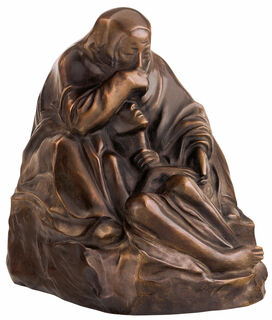Sculpture "Pietà" (1938/39), reduction in bronze
Sculpture "Pietà" (1938/39), reduction in bronze
Quick info
ars mundi Exclusive Edition | limited, 980 copies | numbered | signature | foundry hallmark | certificate | bronze | patinated | reduction | size 21.5 x 14.5 x 21 cm (h/w/d) | weight approx. 4.5 kg
Video
Detailed description
Sculpture "Pietà" (1938/39), reduction in bronze
Käthe Kollwitz (1867-1945) repeatedly used her graphic and sculptural work to give the poor and the oppressed a voice. Kollwitz insisted on humanity even in inhumane times. She especially focused on the motif of the woman and mother, which she turned into a symbol of protection, care, and also innocent suffering. Her sculpture "Pietà" combines both motifs to a certain extent: on the one hand, the mother figure embraces her adult son resting on her lap; on the other hand, the figure is, as the artist herself put it, "something like a Pietà" and thus draws on an art-historical motif showing the suffering of the mother of Jesus facing the dead Christ. Kollwitz, however, expressly did not want her sculpture to be understood religiously. The depicted mother is rather "an old lonely and darkly contemplating woman" (according to Kollwitz), who, one could continue, retains her dignity even in the experience of catastrophe.
Her most famous sculpture was created when the Nazi regime had banned Käthe Kollwitz from working. Today, an enlarged copy in the Neue Wache in Berlin commemorates the "Victims of War and Tyranny".
Sculpture in fine bronze, patinated. Cast by hand using the Lost-Wax-Process. Directly moulded from the original and reduced in size (reduction). Limited edition of 980 copies, individually numbered and with the signature taken from the original and the foundry hallmark. With numbered certificate of authenticity and limitation. Size 21.5 x 14.5 x 21 cm (h/w/d). Weight approx. 4.5 kg. ars mundi Exclusive Edition.
About Käthe Kollwitz
The German graphic artist, painter and sculptor Käthe Kollwitz (1867, Königsberg – 1945, Moritzburg) is considered one of the most important women and artists of the 20th century. Käthe Kollwitz worked on themes that shaped her generation. This resulted in a large oeuvre of prints and drawings that dealt with both cheerful and negative subjects.
In 1898, she achieved a breakthrough with her etchings and lithographs at the great Berlin Art Exhibition. The artist made it her mission to draw attention to injustices and discrimination.
An alloy of copper with other metals (especially with tin) used since ancient times.
When casting bronze, the artist usually applies the lost-wax technique which is dating back more than 5000 years. It's the best, but also the most complex method of producing sculptures.
First, the artist forms a model of his sculpture. It is embedded in a liquid silicone rubber mass. Once the material has solidified, the model is cut out. The liquid wax is poured into the negative mould. After cooling down, the wax cast is removed from the mould, provided with sprues and dipped into ceramic mass. The ceramic mass is hardened in a kiln, whereby the wax flows out (lost mould).
Now we finally have the negative form, into which the 1400° C hot molten bronze is poured. After the bronze had cooled down, the ceramic shell is broken off and the sculpture is revealed.
Now the sprues are removed, the surfaces are polished, patinated and numbered by the artist himself or, to his specifications, by a specialist. Thus, each casting becomes an original work.
For lower-quality bronze castings, the sand casting method is often used which, however, does not achieve the results of a more complex lost-wax technique in terms of surface characteristics and quality.
Graphic or sculpture edition that was initiated by ars mundi and is available only at ars mundi or at distribution partners licensed by ars mundi.
Term for an art object (sculpture, installation), which is produced in multiple copies in a limited and numbered edition according to the artist‘s will.
Artist's multiples have been called the most accessible and affordable art on the market.
A plastic work of sculptural art made of wood, stone, ivory, bronze or other metals.
While sculptures from wood, ivory or stone are made directly from the block of material, in bronze casting a working model is prepared at first. Usually, it is made of clay or other easily mouldable materials.
The prime time of sculpture after the Greek and Roman antiquity was the Renaissance. Impressionism gave a new impulse to the sculptural arts. Contemporary artists such as Jorg Immendorf, Andora, and Markus Lupertz also enriched sculptures with outstanding works.












